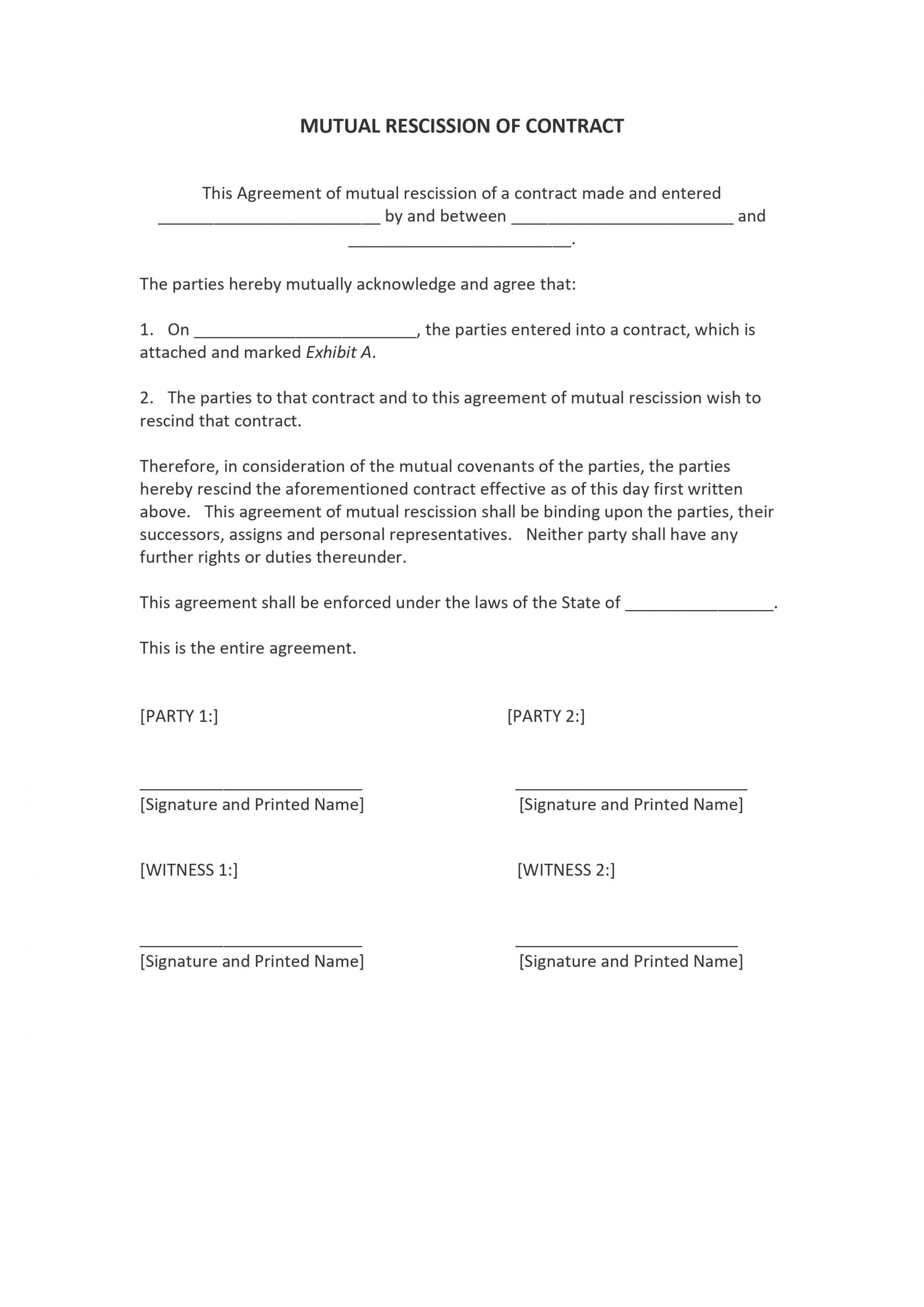- Eviction Notice Forms
- Power of Attorney Forms Forms
- Bill of Sale (Purchase Agreement) Forms
- Lease Agreement Forms
- Rental Application Forms
- Living Will Forms Forms
- Recommendation Letters Forms
- Resignation Letters Forms
- Release of Liability Agreement Forms
- Promissory Note Forms
- LLC Operating Agreement Forms
- Deed of Sale Forms
- Consent Form Forms
- Support Affidavit Forms
- Paternity Affidavit Forms
- Marital Affidavit Forms
- Financial Affidavit Forms
- Residential Affidavit Forms
- Affidavit of Identity Forms
- Affidavit of Title Forms
- Employment Affidavit Forms
- Affidavit of Loss Forms
- Gift Affidavit Forms
- Small Estate Affidavit Forms
- Service Affidavit Forms
- Heirship Affidavit Forms
- Survivorship Affidavit Forms
- Desistance Affidavit Forms
- Discrepancy Affidavit Forms
- Guardianship Affidavit Forms
- Undertaking Affidavit Forms
- General Affidavit Forms
- Affidavit of Death Forms
Mutual Rescission and Release Agreement Form
Did you know that contracts can be annulled? All parties can agree to release their obligations while a contract binds them. Unlike a contract termination, a mutual rescission and release agreement form frees the parties and lets them continue with business without weighing the broken promise on someone’s shoulder. Even though enterprises are likely to use the form, anyone who participated in an agreement can use it. Find out more about a mutual rescission and release agreement form with this article. Continue reading below. Read More
Mutual Rescission and Release Agreement Form
What Is a Mutual Rescission and Release Agreement Form?
A mutual rescission and release agreement form, also known as mutual rescission of contract or equitable rescission, is a legal document used to cancel a contract. If two parties wish to rescind a deal, they can use this form in the process. Someone may think this document as complicated, but it only needs both parties’ rescission and release statements. Also, this form covers various laws. But, its provisions will vary based on the original contract and the state laws above it.
How Do You Create a Mutual Rescission and Release Agreement Form in Four Easy Steps?
According to the Bureau of Justice Statistics and based on the civil bench and jury trials’ first national study, 33% of civil cases filed in state courts was a breach of contract cases. Because of that, there is a need for the court’s intervention whenever a contract is violated. Yet, if the parties mutually agreed to unbind that contract, they may not need a lawsuit.
Hence, the need to create a mutual rescission and release agreement form. Making this form is easier if you are familiar with the original contract’s stipulations. Plus, below is a step-by-step guide in crafting a mutual rescission and release form. Learn more!
1. Talk With the Other Party
Ideally, both parties must fulfill the contract obligations. But, it is not always the case. Sometimes, they can agree to invalidate the contract when those obligations are not met. Without violating the rules, the parties must meet their expectations by consulting each other. Since this process can result in significant changes, make sure to think critically before making decisions. Any action is valid as long as it does not compromise the parties. You can also create a mutual rescission and release agreement form when a deal is not panning out as you had hoped.
2. Provide the Mutual Rescission and Release Clause
There is no guarantee for a contract to work out entirely. Knowing that anything can happen, consider adding a mutual rescission and release clause into your agreement. Although it can stand alone as a separate document, writing makes it accessible whenever the parties desire to invalidate the deal. As long as both parties have a common ground, they can craft the form whenever they wish—no need to wait for the contract’s natural expiration date. And, if these parties want a clean break, this form is their saving grace.
3. Attach a Copy of the Original Contract
If you opt to create a separate document as a mutual rescission and release agreement form, attach the contract’s original copy. Afterward, label it as “Exhibit A.” Doing so presents the document as primary evidence to support the agreement’s rescission and release. It also serves as a reference to enhance the process’s interests. More so, “Exhibit A” exists in case the court needs to inspect its provision. Because canceling a contract varies per location (country, state, etc.), supporting documents are crucial for its implementation.
4. Consult a Notary Public and Sign the Form
After providing the mutual rescission and release clause or “Exhibit A,” sign the document. Make sure it follows the state’s legal requirements before sealing the deal. Doing this signifies that the parties understand all the details in the form. And that they have provided factual information. Although there is no law above the signing of a legal document, we recommend a witness or two.
Some states even require the form’s notarization. In that case, meet with a notary public. Use this opportunity to ask about the agreement’s legitimacy and settle all concerns regarding the arrangement.
Frequently Asked Questions
How to mutually void a contract?
When canceling a contract, communication is everything. If you think the deal is not working out, write a letter to the other party. State that you would like to cancel the contract mutually. Then, indicate the reasons for the deal’s release. After that, ask for a response and agree to make a mutual rescission and release agreement form. Lastly, all the parties must sign the form to make it valid. You can also let at least one witness sign the form if the state requires it.
Why is a mutual rescission important?
All the parties are expected to perform their obligations that come along with signing a contract. But, some of them may stumble. If they turn their back and decide to be free from those obligations, they can use a mutual rescission. With this, there is no need to pursue expensive and time-consuming legal lawsuits.
What is the difference between rescission and cancellation?
Rescission and cancellation of contracts are different terms. To a rescind a contract means going back to undo the deal, whereas cancellation eliminates its validity. There are several reasons to terminate an agreement between two parties. The most common is the breach of contract or violating the terms and conditions. In cases where all the parties mutually agree to terminate the deal, they must rescind the contract instead of terminating it.
Signing a contract has obligations, and both parties must faithfully perform these. But what happens if they cannot? If a party fails to follow the rules, the other party can terminate or rescind the contract. Although both ways are efficient to end the deal, a mutual rescission and release agreement is the safest way to be free from the obligations. Create a mutual rescission and release agreement form today, and worry less if you are to undo a deal!

